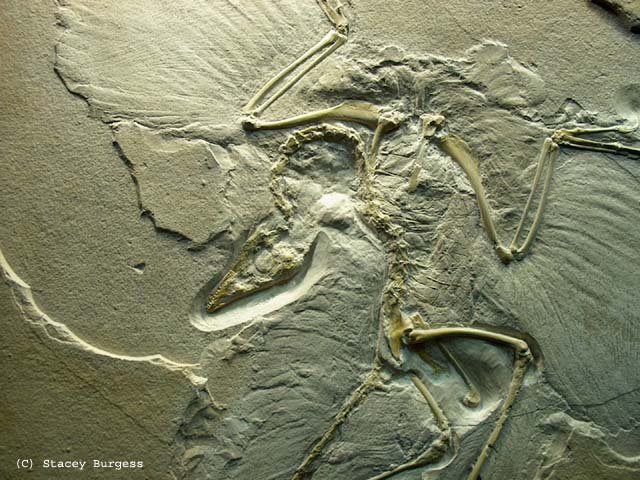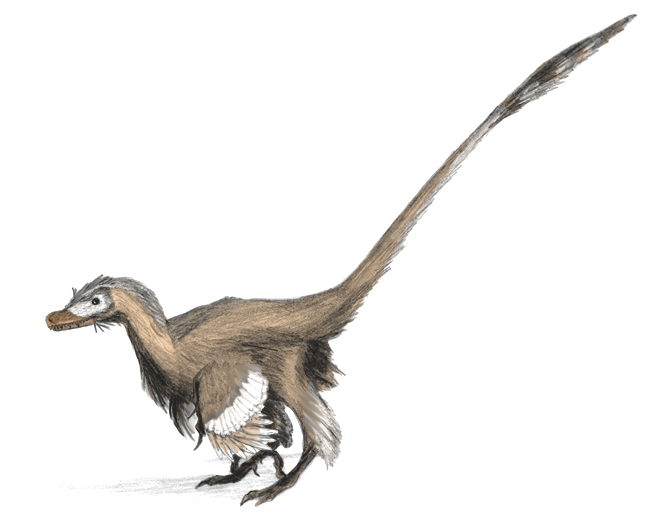No; it's the news that Archaeopteryx may be knocked off its pedestal as the earliest bird in the fossil record, based on a new phylogeny by Xu et al. Archaeopteryx is now deemed to be just another deinonychosaur; probably closer to velociraptor than to birds.

And talk about spectacularly bad timing: this news comes just as we were about to celebrate 150 years since Archaeopteryx's discovery.

The thing is, Archeopteryx has been looking increasingly uncomfortable on that pedestal for quite a while. Murmurs of discontent have been flying around since the 1940s. So why is it all of a sudden no longer considered to be a bird?
We'd better start with defining what we really mean by a bird. In fact, what we mean by "bird" is probably the real nub of the issue.
The birds are a group of therapod dinosaurs, and as such are the only group of dinosaurs still to roam the Earth. (Annoy your friends by mentioning this any time they try to tell you dinosaurs are extinct. I like to tell people that a dinosaur has just shat on their car.) The earliest birds split from other maniraptoran dinosaurs at about 150 Ma.
Here's the tricky bit, then: at what point does a maniraptoran dinosaur become a bird? Back in the day, when we had a lot less fossils, it was a lot easier. Birds have feathers and wishbones. Simple. But slowly, we've found more and more examples of what were thought were bird-only characters turning up in theropod dinosaurs - so much so, that what we now think of as unique to birds is very different.
For a start, feathers. Birds have feathers, dinosaurs don't. End of, right?
Well, for a while now, feathers have been turning up on dinosaurs left right and centre. For a start, Velociraptor, (the most overhyped dinosaur ever, being no bigger than a dog), was covered in feathers, and in fact, many basal dromeosaurs are at least thought to have been able to glide. Even young tyrannosauruses may have had some fine downy feathers. So, these days, feathers don't imply bird at all.

Velociraptor, by Matt Martyniuk. Not so scary now, right?
The next avian characteristic is the wishbone, or furcula. The furcula, as anyone who has boned a chicken before will know, is simply two fused collarbones, and has always been thought to strengthen the chest of birds to withstand the rigours of flight.
Again, now we've started to find more and more theropods that have furculae. Coelophysoids, spinosauroids, allosauroids, tyrannosauroids, compsognathids, oviraptorosaurs - they've all got them.
But these are just two examples. To name a few more previously bird-only features that are now found across the deinonychosaurs, we have the antorbital fossa being dorsally bordered by the nasal and lacrimal, a relatively small number of caudal vertebrae, a relatively large proximodorsal process of the ischium, a relatively long pre-acetabular process of the ilium, fusion of the proximal part of the metatarsus... among others.
Are there any left? Two things that are still bone fide bird features are a reversed hallux (the big toe; in perching birds, it's reversed; this is how they cling onto branches) and a smooth palatine, both of which have always thought to have been present on Archaeopteryx.
However, it's actually pretty difficult to be able to tell orientations of parts of anatomy on fossils, which are almost always 2D. So, opinion has shifted recently to the hallux not being reversed in Archaeopteryx. This might seem like a bit of an oversight, but I must say, I have seen the London specimen of Archaeopteryx, and, truth be told, I actually found it difficult at a first glance to even see where the head was. The fossil of Archeopteryx has the appearance of having been shot out of a cannon at a wall; there's nothing neat about it. So, whether the hallux points forwards or back is very subjective, and likewise with the jugal process on the palatine bone; we no longer think that Archaeopteryx lacks one.
Essentially, then, it's become difficult to have a phylogeny of theropods with Archaeopteryx being the first bird. Under the new phylogeny, this accolade goes to one of Epidexipteryx, Jeholornis and Sapeornis - relatively new kids on the block, having only been around for 10 years or so.

This reclassification also clears up a few other inconsistencies as well. The triangular, sharp-toothed skull of Archaeopteryx was very much a carnivourous skull, and moving it out of birds and into the carnivorous deinonychosaur group makes sense; it now seems clear that herbivory was ubiquitous among basal birds, rather than carnivory re-evolving in this group.

I will say this, though: don't expect this to be the last you've heard of this. I think it is probably quite likely that there may be another reclassification, and Archeopteryx may find itself being reclassified as a bird again. Nonetheless, we a still entering into an era where Archaeopteryx is just one of many animals on the slow transition to birds.
For now, though, I think we should all pay our respects to that icon of evolution that is Archaeopteryx. It is still the original, epitome example of a transitional fossil, and is undoubtedly still the most historically important fossil ever found. Though it has been rather lonely, perched there between theropods and birds, there are now many, many more fossils to keep it company. One thing's for sure, though, and that's that the line between what is a dinosaur and what is a bird is more blurred than ever.
------------
Citations
http://www.nature.com/nature/journal/v475/n7357/full/nature10288.html#/f4
http://www.nature.com/nature/journal/v475/n7357/full/475458a.html#/f2





Comments